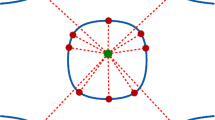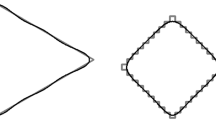Abstract
We consider rationally parameterized plane curves, where the polynomials in the parameterization have fixed supports and generic coefficients. We apply sparse (or toric) elimination theory in order to determine the vertex representation of the implicit equation’s Newton polygon. In particular, we consider mixed subdivisions of the input Newton polygons and regular triangulations of point sets defined by Cayley’s trick. We consider polynomial and rational parameterizations, where the latter may have the same or different denominators; the implicit polygon is shown to have, respectively, up to four, five, or six vertices.
Similar content being viewed by others
References
Corless, R.M., Giesbrecht, M.W., Kotsireas, I.S., Watt, S.M.: Numerical implicitization of parametric hypersurfaces with linear algebra. In: Artificial Intelligence & symbolic Computation, (Madrid, 2000), pp. 174–183. Springer, Berlin (2001)
Cox D.A., Sederberg T.W., Chen F.: The moving line ideal basis of planar rational curves. Comput. Aided Geom. Des. 15(8), 803–827 (1998)
Dickenstein A., Feichtner E.M., Sturmfels B.: Tropical discriminants. J. Am. Math. Soc. 20(4), 1111–1133 (2007)
Dokken, T.: Approximate implicitization. In: Mathematical Methods for Curves and Surfaces (Oslo, 2000), pp. 81–102. Vanderbilt University, Nashville (2001)
D’Andrea C., Sombra M.: The Newton polygon of a rational plane curve. In: Gonzalez-Vega, L., Lazard, S. (eds) Math. in Comp. Science (this Issue), Birkhäuser, Basel (2010)
D’Andrea C., Sombra M.: Rational parametrizations, intersection theory and Newton polytopes. In: Emiris, I.Z., Sottile, F., Theobald, T. (eds) Nonlinear Computational Geometry. IMA Volumes in Math. & Appl., vol. 151, pp. 35–50. Springer, New York (2009)
Emiris, I.Z., Fisikopoulos, V., Konaxis, C.: Regular triangulations and resultant polytopes. 26th Europ. Workshop Comput. Geometry, Dortmund, Germany (2010)
Emiris, I.Z., Kotsireas, I.S.: Implicitization with polynomial support optimized for sparseness. In: Proc. Intern. Conf. Comput. Science & Appl. 2003, Montreal (Intern. Workshop Comp. Graphics & Geom. Modeling). LNCS, vol. 2669, pp. 397–406. Springer, Berlin (2003)
Emiris, I.Z., Kotsireas, I.S.: Implicitization exploiting sparseness. In: Janardan, R., Smid, M., Dutta, D. (eds.) Geometric & Algorithmic Aspects of Comp.-Aided Design & Manufacturing. DIMACS, vol. 67, pp. 281–298. DIMACS (2005)
Emiris, I.Z., Konaxis, C., Palios, L.: Computing the Newton polytope of specialized resultants. MEGA 2007, RICAM (Johann Radon Institute for Computational and Applied Mathematics), Strobl, Austria
Esterov, A., Khovanskii, A.: Elimination theory and Newton polytopes (2007). arXiv.org:math/0611107v2
Gelfand I.M., Kapranov M.M., Zelevinsky A.V.: Newton polytopes of the classical resultant and discriminant. Adv. Math. 84, 237–254 (1990)
Gelfand I., Kapranov M., Zelevinsky A.: Discriminants, Resultants and Multidimensional Determinants. Birkhäuser, Boston (1994)
Michiels T., Verschelde J.: Enumerating regular mixed-cell configurations. Discret. Comp. Geom. 21(4), 569–579 (1999)
Philippon, P., Sombra, M.: A refinement of the Kusnirenko–Bernstein estimate. Tech. Report (2007). arXiv.org:0709.3306
Santos, F.: The Cayley trick and triangulations of products of simplices. In: Integer Points in Polyhedra: Geometry, Number Theory, Algebra, Optimization. Contemporary Mathematics, vol. 374, pp. 151–177. AMS, Philadelphia (2005)
Sederberg T.W.: Improperly parametrized rational curves. Comput. Aided Geom. Des. 3(1), 67–75 (1986)
Sendra, J.R., Winkler, F.: Computation of the degree of rational maps between curves. In: Proc. Intern. Symp. Symbolic & Algebraic Computation, pp. 317–322. ACM Press, New York (2001)
Sturmfels B.: On the Newton polytope of the resultant. J. Algebraic Comb. 3(2), 207–236 (1994)
Sturmfels, B., Tevelev, J., Yu, J.: The Newton polytope of the implicit equation. Moscow Math. J. 7(2) (2007)
Sturmfels B., Yu J.T.: Minimal polynomials and sparse resultants. In: Orecchia, F., Chiantini, L. (eds) Zero-Dimensional Schemes Proc Ravello, June 1992, pp. 317–324. De Gruyter, Berlin (1994)
Sturmfels B., Yu J.: Tropical implicitization and mixed fiber polytopes. In: Stillman, M., Verschelde, J., Takayama, N. (eds) Software for Algebraic Geometry. IMA Volumes in Math. & its Appl., vol 148, pp. 111–131. Springer, New York (2008)
Author information
Authors and Affiliations
Corresponding author
Rights and permissions
About this article
Cite this article
Emiris, I.Z., Konaxis, C. & Palios, L. Computing the Newton Polygon of the Implicit Equation. Math.Comput.Sci. 4, 25–44 (2010). https://doi.org/10.1007/s11786-010-0046-1
Received:
Revised:
Accepted:
Published:
Issue Date:
DOI: https://doi.org/10.1007/s11786-010-0046-1




